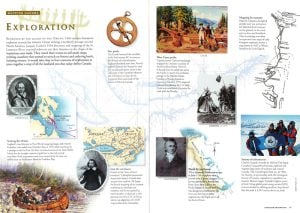In March 1947, Richard Finnie wrote an article on the creation of a land-based oil pipeline originating in the Norman Wells oil fields in the Northwest Territories and splitting off into the Yukon and the Alaska panhandle. Known as the “Canol Project” (short for Canadian oil), it was kept secret to most Canadians during its construction, as it had been proposed as a defensive act against possible Japanese invaders during the Second World War. The idea was American-sponsored, though Canadian involvement was imperative. The goal was to fuel the Alaska Highway and airports—and also American fighter planes—and ideally produce up to 3,000 barrels of oil each day.
The entire project was highly spoken of. With it, the oil company, in conjunction with the military and Canadian Transport system, could not only access these useful resources, but at the same time develop roads high into the north in an area that was described as “an immense, undeveloped region, much of which was hardly explored.” Small airports were also developed within northern Canada for the first time.
There was very little pushback to the development—either due to the different mindset of the war-torn time, or, more likely, lack of public awareness about the project.
The project, which was originally proposed in 1942, was completed within 22 months and did not end up being a war requirement (though it did gather about seven times more oil than anticipated). While the original intentions of this project were not necessarily for the good, its existence probably made a significant contribution to Canadian post-war development.
In the end, Finnie notes, Canol “was not only one of the war’s most unusual construction projects, it was also one of the most enduringly beneficial.”
This lofty description of a major, environment-threatening project lies in stark contrast to today’s proposed Northern Gateway Project between Edmonton, Alta. and Kitimat, B.C. , which has been roundly criticized by communities, NGOs and politicians.
The Canol service road was designated a National Historic Site in 1990 and is today considered one of the toughest hiking trails in Canada.





